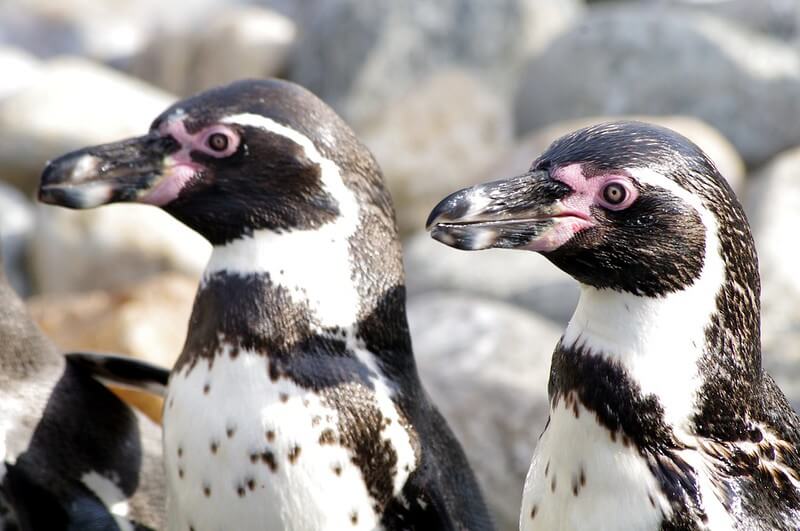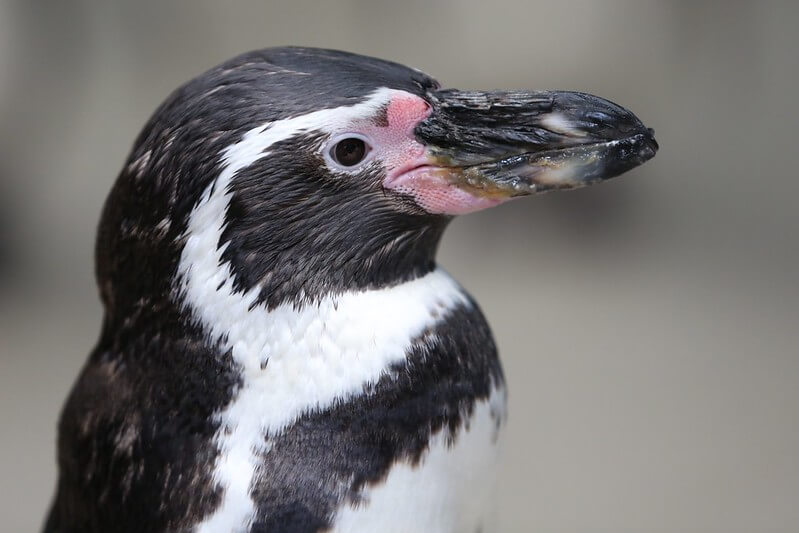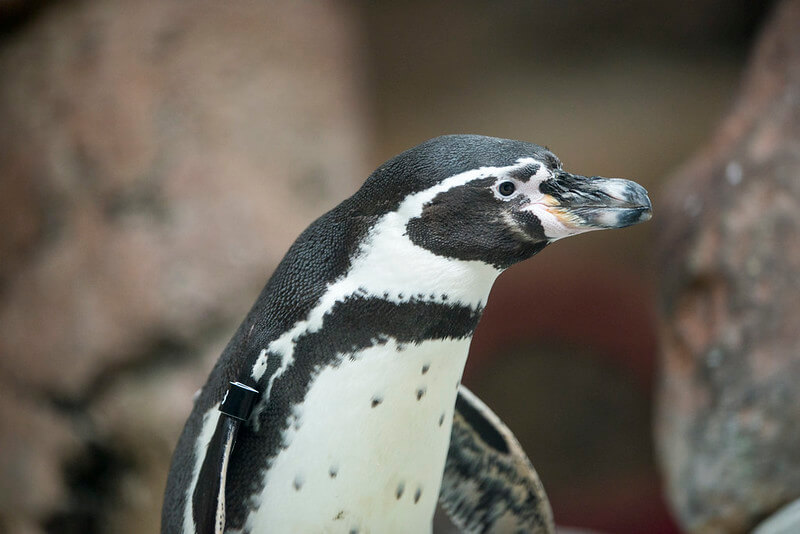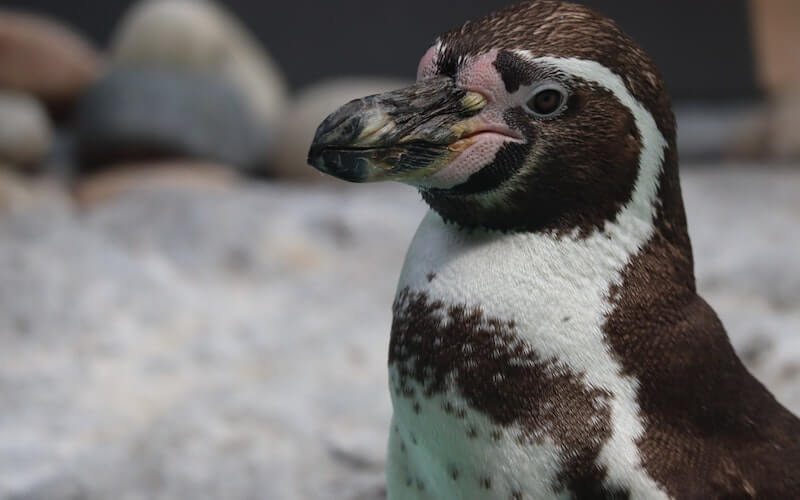When thinking about penguins it’s easy to immediately picture icy landscapes full of snow where these flightless marine birds assemble by the thousands.
While this may be true for some species there are a few penguins that enjoy tropical beaches just like you and me.
Humboldt penguins are some of these palm tree-loving, tuxedo-wearing little guys and there is so much to unpack when it comes to this particular species.
For that reason today I will share with you 15 interesting Humboldt penguin facts that will help you get more familiar with this beloved bird.
Without further delay, I bring you this delightful compilation:
1. Humboldt Penguins Live In Warm Weather
Humboldt penguins inhabit the western coasts of South America, most specifically the coasts of Peru and Chile.
It can get as hot as 42° Celsius / 108° Fahrenheit where these birds live which sounds pretty drastic for a penguin.
However, the waters are not quite as warm and in fact, these birds get their name because of the chilly Humboldt current that moves north from Antarctica along the pacific ocean where the Humboldt penguins live.
2. Humboldt Penguins Blush
If you ever see a Humboldt penguin that is not only black and white but has some dashes of bright pink around the face don’t think it’s just trying some trendy look.
This pink coloration comes from an amazing adaptation to remain cool while inhabiting such warm temperatures.
Humboldt penguins have exposed patches of bare skin around their face, feet, and underside of their wings that “blush” when it gets too hot.
This is because blood flow is directed toward the bare skin in order to expel heat through these exposed areas, therefore, avoiding overheating.
3. Humboldt Penguins Build Their Nests From Poop
Unlike other penguin species that choose to build nests out of rocks, twigs, or rely on caves, Humboldt penguins are a bit extreme and will make their nests out of guano which is the poop of different sea bird species.

Due to the dry weather along the western South American coastline, the poop from seabirds turns very dry and will build up year after year creating a guano layer that can be several feet deep.
Humboldt penguins will then dig into the layers of this dried guano to make a burrow to nest in.
4. Humboldt Penguins Are Quite Athletic
Even though Humboldt penguins may appear clumsy while walking on land they are decent jumpers and climbers which is very helpful when navigating the rocky beaches they prefer to inhabit.
5. Humboldt Penguins Are Very Popular
Since Humboldt penguins thrive in warmer temperatures they are one of the species most commonly found throughout zoos and aquariums.
6. Humboldt Penguins Are Hatching Fewer Chicks Because Of Humans
Unfortunately for Humboldt penguins, humans discovered that the guano they use to build their nests is a great fertilizer and have been harvesting it non-stop ever since.
Of course, the penguins’ nesting habits are not taken into account by miners harvesting the guano and they will leave the rocks completely clean of it so the penguins have none left to be able to create their nests.
As a result, Humboldt penguins have been hatching far fewer chicks.
7. Humboldt Penguins Have A Built In Insulation System And Waterproof Suit
Humboldt penguins may inhabit warm habitats but the pacific ocean has really cold water so these birds must somehow remain warm and waterproof.
For this reason, Humboldt penguins are equipped with 3 layers of short feathers that overlap creating a tight seal that prevents water from reaching their down feathers.
And what keeps them warm is a thick layer of fat and blubber right under their skin.
8. Humboldt Penguins Have A Characteristic Black Breast Band
Humboldt penguins closely resemble their cousin the Magellanic penguin.
One fail-proof way to tell them apart is because the Humboldt penguin has a single, solid black stripe that goes over its chest while the latter species has 2.
9. Humboldt Penguins Are Extremely Sensible To Human Presence
Studies have shown that areas with heavy tourist activity show a significant reduction in Humboldt penguin breeding success.

Other studies have shown that when there is a human 150 m / 492 feet away from a penguin this bird will experience a dramatic increase in its heart rate and it can take as long as 30 minutes after the encounter for the penguin to recuperate.
This response to human presence is thought to be an evolutionary adaptation due to the penguin’s history of being excessively hunted.
10. Humboldt Penguins Are Medium Sized
Adult Humboldt penguins can reach a height of between 66 – 70 cm / 26 – 28 in. and an average weight of 4 – 5 kg / 9 – 11 lbs. which makes them medium-sized when compared with the other 17 penguin species.
11. Humboldt Penguins Can Dive Really Deep
Humboldt penguins tend to forage at depths of around 60 m / 197 feet, however, it isn’t uncommon for these birds to dive as deep as 150 m / 492 feet.
For reference, 150 m / 492 feet is the minimum height for a building to be considered a skyscraper.
12. Humboldt Penguins Don’t Have A Breeding Season
While there are peaks in April, August, and September Humboldt penguins are able to breed year-round thanks to living in a warmer climate and their breeding seems to be related mostly to food availability.
This enables them to regularly, and successfully, produce 2 clutches per year.
13. Humboldt Penguin Females Will Sometimes Engage In Open Relationships
Humboldt penguins are monogamous and mate for life. Nonetheless, sometimes a female penguin in a bonded pair will seek out another male for mating.
This is always done by the female, while male Humboldt penguins in a bonded pair will only mate with their partner.
Another interesting event that has been observed only in Humboldt penguins is called “usurps” and it’s when a single male invades the nest of a mated pair in an attempt to mate with the female.
These encounters turn aggressive and can even lead to the death of one of the males.
14. Humboldt Penguins Fast For 2 Weeks
Humboldt penguins go on a 2 week fast in January while going through their annual molt.
When molting, penguins lose all their feathers at once and grow new ones but during this process, they are unable to go on foraging dives as they lack their waterproof feathers.

15. Humboldt Penguins Are Long-Lived
Humboldt penguins usually live for around 20 years. This number becomes much higher for captive penguins who have access to veterinary care, proper diet, and lack of predators with some of them living well into their 30s.
The oldest Humboldt penguin is a female named Rosie who recently celebrated her 32nd birthday at the Sewerby Zoo in East Yorkshire.
I am a lover of everything nature and animal related with over 15 years of experience in the field of wildlife rescue and education. Currently living in Colombia working with wild and domestic animals and spending all my free time writing about them 🙂

